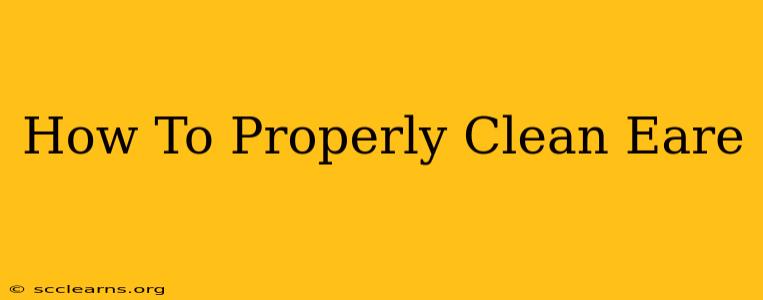Earwax, or cerumen, is a naturally occurring substance produced by your ears. It plays a crucial role in protecting your ears from infection, dust, and other foreign objects. While it's essential, excessive buildup can lead to discomfort and even hearing problems. This guide will teach you how to properly clean your ears safely and effectively, avoiding common mistakes that can lead to injury.
Understanding Your Ears: Why You Shouldn't Use Cotton Swabs
Before we dive into cleaning methods, it's vital to understand the anatomy of your ear canal. Pushing things into your ear canal, especially cotton swabs, is a common mistake that can cause serious damage. Cotton swabs push wax deeper into the canal, potentially compacting it and leading to:
- Impacted earwax: This can cause hearing loss, earaches, itching, and even infection.
- Ear canal injury: Swabs can scratch or perforate the delicate skin lining your ear canal.
- Infection: Pushing bacteria deeper into the ear increases the risk of infection.
Instead of using cotton swabs, focus on cleaning the outer ear only.
Safe and Effective Ear Cleaning Methods
The following methods are recommended for maintaining clean ears and preventing wax buildup:
1. The Gentle Wipe:
- After showering or bathing, gently wipe the outer ear with a clean, damp washcloth. This removes any visible dirt and excess wax on the outer portion of the ear. Avoid inserting the cloth into the ear canal.
2. Ear Drops (When Necessary):
- Over-the-counter ear drops can help soften earwax and allow it to naturally drain. Always follow the instructions on the product label carefully. Some ear drops are specifically designed to break down and loosen earwax buildup.
3. Saline Irrigation (With Medical Supervision):
- Saline irrigation, or ear flushing, involves using a gentle stream of warm, sterile saline solution to rinse out earwax. This method should only be performed under the guidance of a doctor or healthcare professional. Improper technique can lead to injury or infection.
4. Professional Ear Cleaning:
- If you experience significant earwax buildup, hearing loss, ear pain, or other symptoms related to impacted earwax, consult an ear, nose, and throat (ENT) specialist. They can safely and effectively remove excess wax using specialized instruments.
What to Avoid When Cleaning Your Ears:
- Cotton swabs: As previously mentioned, avoid using cotton swabs at all costs.
- Sharp objects: Never insert anything sharp or pointy into your ear canal, such as bobby pins or paper clips.
- Ear candles: These are completely ineffective and can be dangerous.
- Excessive cleaning: Don't try to clean your ears too frequently, as this can irritate the ear canal and stimulate more wax production.
When to See a Doctor:
Seek medical attention immediately if you experience:
- Sudden hearing loss
- Severe ear pain
- Discharge from the ear
- Ear infection symptoms (fever, redness, swelling)
- Persistent itching or discomfort
By following these safe and effective ear cleaning practices, you can maintain healthy ears and prevent potential problems. Remember, less is more, and focus on cleaning the outer ear rather than attempting to clean deep inside. If you have any concerns, always consult your doctor or an ENT specialist.

